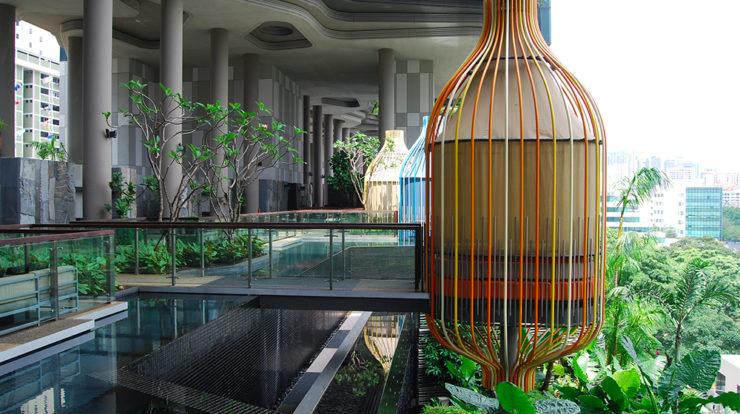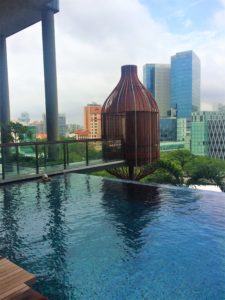

Features
Two New Biophilic Design Case Studies
Dakota Walker
Share
What makes a space biophilic? While compiling case studies of exemplary biophilic design, it is clear to see that these spaces come in many different shapes and sizes. One characteristic that all of these sites share is that they each create a unique sense of place.
This couldn’t be more true of our two new biophilic design case studies. The Östra Hospital in Sweden puts their patients and staff first with a design that highlights calming, restorative spaces and a layout informed by nature’s design expertise. The Parkroyal on Pickering, a hotel in Singapore, mirrors the lush landscape of the adjacent park offering guests a unique, nature-immersed experience. These case studies don’t just reinforce the wide range of sites and project types that can make use of biophilic design. The Östra Hospital illustrates the benefits of biophilic design in healthcare facilities, while Parkroyal on Pickering is the first of our case studies to illustrate the biophilic patterns Complexity & Order and Risk/Peril.
Östra Hospital
The Östra Hospital is a stunning example of thoughtful and focused design. Throughout the design process, White Architects had a singular design vision: using architecture as a tool to alleviate suffering and encourage mental health recovery. The architects carefully considered every aspect of patient experience, all the while adhering to the strict safety and security standards required of a psychiatric facility. White Architects were cognizant of the importance of place-making in a facility where patients may have extended stays. Complexity & Order made use of repetition within spaces to support a sense of ownership by patients; by nesting social spaces – from private, to semi-private, to semi-public – patients can engage in a range social settings according to their personal preference. The hospital also features Visual Connection with Nature, Dynamic and Diffused Light, and Refuge, all of which come together to create a calming and restorative environment.
“This is the first quantifiable study ever undertaken in Sweden concerning the importance of the physical environment for the healing process in psychiatry”
Having moved from a previous location, Östra conducted a pioneering study examining the empirical benefits of biophilic design on patient experience. The results showed improvements in indicators of both patient and staff wellbeing.
Parkroyal on Pickering

Brightly colored bird cages, accessible by narrow cantilevered platforms, offer views of the city. Image courtesy of Terrapin Bright Green.
WOHA’s Parkroyal on Pickering marries Singapore’s bustling city identity with the lush habitat that surrounds it. Its uniquely earth-inspired design, strong connection to the outdoors, and use of biodiverse sky-gardens truly embodies the city’s cultural identity as a “City in a Garden.” Curvilinear concrete slabs stretch across the exterior of the building, supporting lush sky-gardens and amenities above. Resembling soil layers or terraced landscapes, these biomorphic forms and patterns repeat throughout the interior as well, creating a visually stimulating organic experience. And with 49,000 sqft of created green space, guests are sure to be within view of nature.
Key to any exemplary biophilic structure or space is a designers consideration of regional characteristics, cultural identity, and desired occupant experience. Whether it’s a lush, restorative environment to immerse guests, or an organized, calming environment to create a healing environment, these case studies show the benefits of biophilic design across building types and climates.
Click the links below to read both case studies:
Östra Psychiatry Hospital, White Architects, Göteborg, Sweden – PDF (2MB)
Parkroyal on Pickering, WOHA Architects, Singapore, Singapore – PDF (4MB)
Click here to view and download all of our biophilic design case studies.
Filed under:
Dakota Walker
Dakota Walker is an Associate Project Manager & Research Analyst at Terrapin Bright Green. He recently graduated summa cum laude from the University of North Carolina Asheville with a degree in Environmental Management and Policy. Dakota believes the genius of nature has yet to be matched by human innovation. He’s interested in finding new approaches to solving contemporary policy and design challenges that reflect the resilience and resourcefulness of natural systems.
Topics
- Environmental Values
- Speaking
- LEED
- Terrapin Team
- Phoebe
- Community Development
- Greenbuild
- Technology
- Biophilic Design Interactive
- Catie Ryan
- Spanish
- Hebrew
- French
- Portuguese
- Publications
- Occupant Comfort
- Materials Science
- Conference
- Psychoacoustics
- Education
- Workshop
- Mass Timber
- Transit
- Carbon Strategy
- connection with natural materials
- interior design
- inspirational hero
- biophilia
- economics of biophilia
- Sustainability
- wood
- case studies
- Systems Integration
- Biophilic Design
- Commercial
- Net Zero
- Resorts & Hospitality
- Energy Utilization
- Water Management
- Corporations and Institutions
- Institutional
- Ecosystem Science
- Green Guidelines
- Profitability
- Climate Resiliency
- Health & Wellbeing
- Indoor Environmental Quality
- Building Performance
- Bioinspired Innovation
- Biodiversity
- Residential
- Master Planning
- Architects and Designers
- Developers and Building Owners
- Governments and NGOs
- Urban Design
- Product Development
- Original Research
- Manufacturing
- Industrial Ecology
- Resource Management
- Sustainability Plans
- Health Care
- Carbon Neutrality


